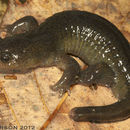ar
الأسماء في صفحات التنقل


The Korean salamander (Hynobius leechii), or Gensan salamander, is the most common species of salamander on the Korean peninsula, and is also found and on Jeju Island and in the north-eastern Chinese provinces of Liaoning, Jilin and Heilongjiang. It typically lives on forested hills, and from time to time mass deaths occur in Korea when salamanders encounter man-made drainage structures. This has prompted Korean government officials to execute a series of mass evacuations in heavily salamandered areas.
The Korean salamander (Hynobius leechii), or Gensan salamander, is the most common species of salamander on the Korean peninsula, and is also found and on Jeju Island and in the north-eastern Chinese provinces of Liaoning, Jilin and Heilongjiang. It typically lives on forested hills, and from time to time mass deaths occur in Korea when salamanders encounter man-made drainage structures. This has prompted Korean government officials to execute a series of mass evacuations in heavily salamandered areas.